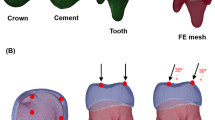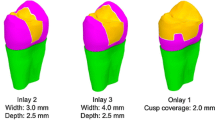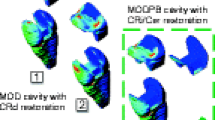Abstract
To assess the effect of preparation taper, height and margin design under different loading conditions on cement lute stress. A 3-D FE model of an upper second premolar and molar was developed from CT scan of human skull using software programmes (MIMICS, Hypermesh and ANSYS). 10° and 30° taper, 3 and 5 mm preparation height and shoulder and chamfer finish lines were used. Type 1 Glass ionomer cement with 24 μm lute width was taken and the model was loaded under 100 N horizontal point load, vertical point load distributed axial load. The maximum shear stress and Von Mises stress within the cement lute were recorded. The maximum shear stresses ranged from 1.70 to 3.93 MPa (horizontal point loading), 0.66 to 3.04 MPa (vertical point loading), 0.38 to 0.87 MPa (distributed loading). The maximum Von Mises stresses ranged from 3.39 to 10.62 MPa (horizontal point loading), 1.93 to 8.58 MPa (vertical point loading) and 1.49 to 3.57 MPa (distributed loading). The combination of 10° taper and 5 mm height had the lowest stress field while the combination of 30° taper and 5 mm height had the highest stress field. Distributed axial loading shows least stress, better stress homogenization and gives a favorable prognosis for the fixed prostheses. Smaller preparation taper of 10° is biomechanically more acceptable than a 30° taper. It is desirable to decrease taper as height increases. The chamfer margin design is associated with greater local cement stresses toward the margins that could place the cement at greater risk for microfracture and failure.








Similar content being viewed by others
References
Wiskott HWA, Nicholls JI, Belser UC (1997) The effect of tooth preparation height and diameter on the resistance of complete crowns to fatigue loading. Int J Prosthodont 10:207–215
Kaufman EG, Coelho DH, Colin L (1961) Factors influencing the retention of cemented gold castings. J Prosthet Dent 11:487–502
Smith CT, Gary JJ, Conkin JE, Franks HL (1999) Effective taper criterion for the full veneer crown preparation in preclinical prosthodontics. J Prosthod 8:196–200
Wiskott HWA, Belser UC, Scherrer SS (1999) Compressive and tensile zones in the cement interface of full crowns: a technical note on the concept of resistance. J Prosthodont 8:80–91
Cameron SM, Morris WJ, Stephen M, Keesee SM, Barsky TB, Parker MH (2006) The effect of preparation taper on the retention of cemented cast crowns under lateral fatigue loading. J Prosthet Dent 95:456–461
Leong EWJ, Tan KBC, Nicholls JI, Chua EK, Wong KM, Neo JCL (2009) The effect of preparation height and luting agent on the resistance form of cemented cast crowns under load fatigue. J Prosthet Dent 102:155–164
Zidan O, Ferguson GC (2003) Retention of complete crowns prepared with three different tapers and luted with four different cements. J Prosthet Dent 89:565–571
Mowafy OME, Fenton AH, Forrester N, Milenkovic M (1996) Retention of metal ceramic crowns cemented with resin cements: effects of preparation taper and height. J Prosthet Dent 76:524–529
Jorgensen KD (1955) The relationship between retention and convergence angle in cemented veneer crowns. Acta Odontol Stand 13:35–40
Wiskott HWA, Nicholls JI, Belser UC (1996) The effect of tooth preparation height and diameter on the resistance of complete crowns to fatigue loading. Int J Prosthodont 9:117–130
Bowley JF, Kieser J (2007) Axial-wall inclination angle and vertical height interactions in molar full crown preparations. J Dent 35:117–123
Parker MH, Caluerlty MJ, Gardner FM, Gunderson RB (1993) New guidelines for preparation taper. J Prosthodont 2:61–66
Nordlander J, Weir D, Stoffer W, Ochi S (1988) The taper of clinical preparations for fixed prosthodontics. J Prosthet Dent 60:148–151
Wilson AH, Chan DCN (1994) The relationship between preparation convergence and retention of extracoronal retainers. J Prosthodont 3:74–78
Marchioril M, Garbin CA, Rigo L, Nunes DB, Mamani GMM (2010) Influence of preparation height and luting agent type on crown retention in molars. Braz J Oral Sci 9:89–93
Goodacre CJ, Campagni WV, Aquilino SA (2001) Tooth preparations for complete crowns: an art form based on scientific principles. J Prosthet Dent 85:363–376
Boeve JAD, McCall WD, Holden S, Ash MM (1978) Functional occlusal forces: an investigation by telemetry. J Prosthet Dent 40:326–333
Dejak B, Mlotkowski A, Romanowicz M (2003) Finite element analysis of stresses in molars during clenching and mastication. J Prosthet Dent 90:591–597
Jacobsen PH, Wakefield AJ, Doherty DMO, Rees JS (2006) The effect of preparation height and taper on cement lute stress: a three-dimensional finite element analysis. Eur J Prosthodont Rest Dent 14:151–157
Ebrashi MKE, Craig RG, Peyton FA (1969) Experimental stress analysis of dental restorations Part III. The concept of the geometry of proximal margins. J Prosthet Dent 22:333–345
Craig RC, Ebrushi MKE, LePeak PJ, Peyton FA (1967) Experimental stress analysis of dental restorations Part I. Two-dimensional photoelastic stress analysis of inlays. J Prosthet Dent 17:277–291
Farah JW, Craig RG (1974) Stress analysis of three marginal configurations of full posterior crowns by three-dimensional photoelasticity. J Dent Res 53:1219–1225
Ebrashi MKE, Craig RG, Peyton FA (1967) Experimental stress analysis of dental restorations. Part II. Two-dimensional photoelastic stress analysis of crowns. J Prosthet Dent 172:292–302
Ebrashi MKE, Craig RG, Peyton FA (1969) Experimental stress analysis of dental restorations. Part IV. The concept of parallelism of axial walls. J Prosthet Dent 22:346–353
Vasudeva G (2009) Finite element analysis: a boon to dental research. Internet J Dent Sci 6:3
Kamposiora P, Papavasiliou G, Bayne SC, Felton DA (2000) Predictions of cement microfracture under crowns using 3D-FEA. J Prosthodont 9:201–209
Proos KA, Swain MW, Ironside J, Steven GP (2003) Influence of cement on a restored crown of a first premolar using finite element analysis. Int J Prosthodont 16:82–90
Proos KA, Swain MW, Ironside J, Steven GP (2002) Finite element analysis studies of a metal–ceramic crown on a first premolar tooth. Int J Prosthodont 15:521–527
Farah JW, Craig RG (1974) Finite element stress analysis of a restored axisymmetric first molar. J Dent Res 53:859–866
Proos KA, Swain MW, Ironside J, Steven GP (2003) Influence of margin design and taper abutment angle on a restored crown of a first premolar using finite element analysis. Int J Prosthodont 16:442–449
Kamposiora P, Papavasilious G, Bayne SC, Felton DA (1994) Finite element analysis estimates of cement microfracture under complete veneer crowns. J Prosthet Dent 71:435–441
Rubin C, Krishnarnurthy N, Capilouto E, Yi H (1983) Stress analysis of the human tooth using a three-dimensional finite element model. J Dent Res 62:82–86
Morin DL, Cross M, Voller VR, Douglas WH, DeLong R (1988) Biophysical stress analysis of restored teeth: modelling and analysis. Dent Mater 4:77–84
Nicholls JI (1974) Crown retention. Part II. The effect of convergence angle variation on the computed stresses in the luting agent. J Prosthet Dent 31:179–184
Anusavice KJ, Hojjatie B (1987) Stress distribution in metal–ceramic crowns with a facial porcelain margin. J Dent Res 66:1493–1498
DeLong R, Douglas WH (1983) Development of an artificial oral environment for the testing of dental restoratives: bi-axial force and movement control. J Dent Res 62:32–36
Trier AC, Parker MH, Cameron SM, Brousseau JS (1998) Evaluation of resistance form of dislodged crowns and retainers. J Prosthet Dent 80:405–409
Fusayama T, Iwamoto T (1961) Optimum cement film thickness for maximum shear resistance between teeth and restorations. Tokyo Med Dent Univ Bull 8:147–164
Jorgensen KD, Esbensen AL (1968) The relationship between the film thickness of zinc phosphate cement and the retention of veneer crowns. Acta Odontol Scand 26:169–175
Mayhew RB, Phillips RL, Haney SJ, Hawley RJ, Wilson AH, Pierson WP (1962) The effect of varying cement thicknesses on the retention of cast gold crowns. J Indiana Dent Assoc 61:9–11
Shillingburg HT, Hobo S, Whitsett LD, Jacobi R, Brackett CE (1997) Fundamentals of fixed prosthodontics, 3rd edn. Quintessence, Berlin, pp 139–154
Rosensteil SF, Land MF, Fujimoto J (2001) Contemporary fixed prosthodontics, 4th edn. Mosby, St. Louis, pp 272–285
Michalakis KX, Stratos A, Hirayama H, Kang K, Touloumi F, YukioOishi Y (2009) Fracture resistance of metal ceramic restorations with two different margin designs after exposure to masticatory simulation. J Prosthet Dent 102:172–178
Wiskott HW, Nicholls JI, Belser UC (1995) Stress fatigue: basic principles and prosthodontic implications. Int J Prosthodont 8:105–116
Chai JY, Steege JW (1992) Effects of labial margin design on stress distribution of a porcelain-fused-to-metal crown. J Prosthodont 1:18–23
Author information
Authors and Affiliations
Corresponding author
Rights and permissions
About this article
Cite this article
Tripathi, S., Amarnath, G.S., Muddugangadhar, B.C. et al. Effect of Preparation Taper, Height and Marginal Design Under Varying Occlusal Loading Conditions on Cement Lute Stress: A Three Dimensional Finite Element Analysis. J Indian Prosthodont Soc 14 (Suppl 1), 110–118 (2014). https://doi.org/10.1007/s13191-014-0378-7
Received:
Accepted:
Published:
Issue Date:
DOI: https://doi.org/10.1007/s13191-014-0378-7




